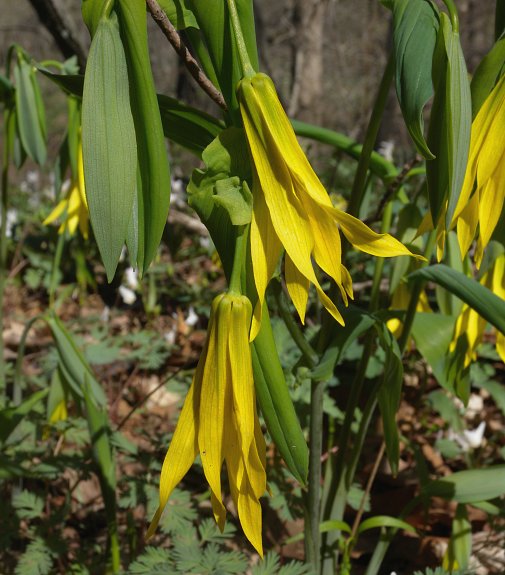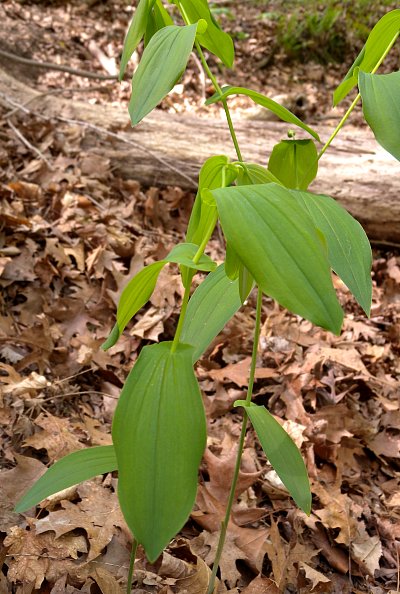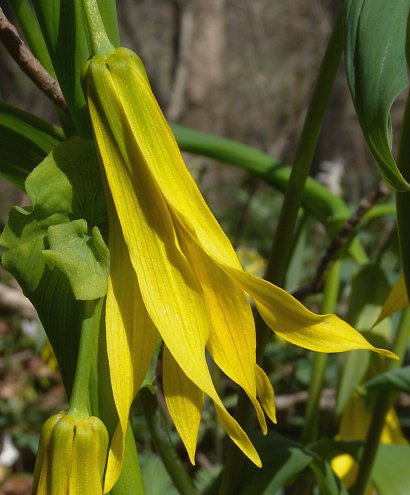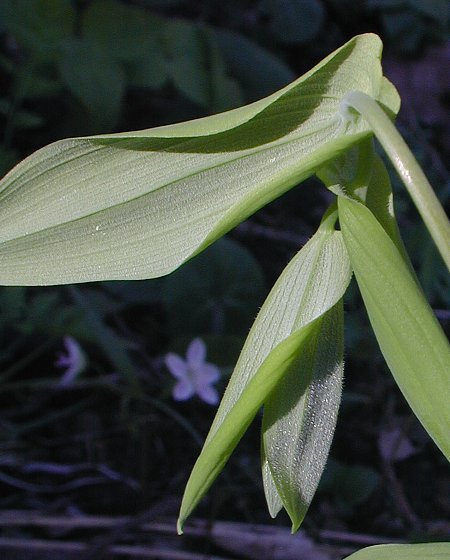Description: This herbaceous perennial plant is about 1-2' tall. In mature plants, the central stem divides into 2 or 3 side stems, while immature plants usually remain undivided. The upper portion of each plant tends to nod downward because of the weight of the leaves and flowers. The terete stems are glabrous and glaucous; they are light green or pale reddish green. The alternate leaves are up to 6" long and 2" across. They are oblong-ovate to elliptic, smooth along their margins, and parallel-veined. The base of each leaf is perfoliate – it completely surrounds the stem. The upper surface of each leaf is pale green to green and glabrous, while the lower surface is white to greenish white and finely short-pubescent (canescent). In mature plants, each side stem terminates with a single flower that has an elongated bell-like shape.

The flowers are about 1-2" long and they hang downward from slender pedicels about 1" long. The pedicels are similar to the stems, except they are more slender. Each flower consists of 6 pale yellow to yellow tepals, 6 stamens, and a pistil with a tripartite style. The slender tepals are slightly twisted and greenish toward the base of the flower, while their interior surface is smooth and hairless. The yellow anthers of the stamens are large and elongated, but they remain mostly hidden by the tepals. The blooming period occurs during the mid-spring and lasts about 2 weeks. The flowers are slightly fragrant. Each flower is replaced by a 3-celled seed capsule that is obovoid in shape with 3 rounded lobes and a rounded tip; each cell of this capsule contains several seeds. The root system is rhizomatous, from which vegetative offsets are often produced. This plant occasionally forms colonies.

Cultivation:
The
preference is dappled sunlight during the spring and light shade during
the summer. The soil should be moderately moist and loamy with a layer
of decaying leaves. It is best to locate this plant underneath a
deciduous tree that does not cast heavy shade during the
summer. It is easier to start new plants from divisions, rather than by
seeds.
Range & Habitat:
The native Large-Flowered Bellwort occurs occasionally in most areas of
Illinois, except for a few counties in southern part of the state (see
Distribution
Map).
Populations of this wildflower have declined
somewhat because of deer-browsing, habitat destruction, invasion of
various non-native shrubs, and invasion of Garlic Mustard (Alliaria petiolata).
Habitats include mesic deciduous woodlands, wooded slopes, large river
banks in wooded areas, and edges of shady seeps. The presence of this
plant in a deciduous woodlands is an indication that much of the
original ground flora is still intact.

Faunal
Associations:
Bumblebees, mason bees (Osmia
spp.), Halictid bees (Halictus
spp., Lasioglossum
spp.), and Andrenid bees (Andrena spp.) suck
nectar or collect pollen from the flowers. The seeds are distributed by
ants because of their attached elaiosomes (small food bodies). The
foliage is heavily grazed by deer; this species declines in abundance
when there is an overpopulation of deer in wooded areas. The foliage is
probably vulnerable to other mammalian herbivores as well.
Photographic Location:
A deciduous woodland along a river bank at Allerton Park in Piatt
County, Illinois.

Comments: The flowers are rather shy and often hide behind the leaves. The foliage of Large-Flowered Bellwort (Uvularia grandiflora) is attractive and resembles the foliage of Polygonatum commutatum (Smooth Solomon's Seal). However, the leaves of the latter species are sessile or clasping, while the leaves of Large-Flowered Bellwort are perfoliate. The only other species in this genus that occurs in Illinois (the southern part only) is Uvularia sessilifolia (Sessile-Leaved Bellwort). As the name suggests, the leaves of this species are sessile, rather than perfoliate, and its flowers are a little smaller than those of Large-Flowered Bellwort. The 3-celled seed capsules of this species are sharply lobed (even winged), while the corresponding lobes of Large-Flowered Bellwort are well-rounded. Another species in this genus, Uvularia perfoliata (Perfoliate Bellwort), occurs in areas to the east of Illinois. This species has perfoliate leaves like Large-Flowered Bellwort. However, its seed capsules are truncated at their tips and its tepals have glandular hairs on the interior surface. Large-Flowered Bellwort has seed capsules with rounded tips and its tepals are smooth on the interior surface.